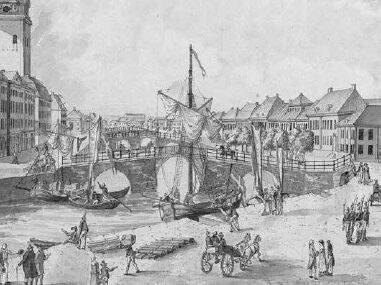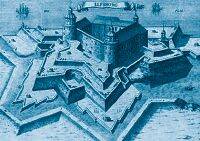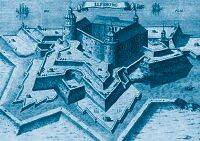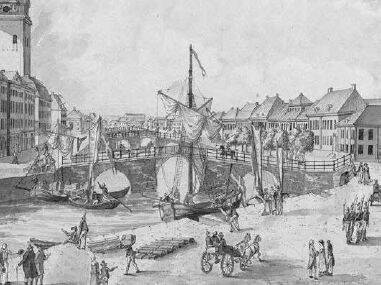



EXPORT OF IRON AND TIMBER
In the 1600s, Gothenburg mainly exported iron and timber from its port. Goods were transported on barges between the Great Harbour Canal and ships anchored offshore.
NEW ÄLVSBORG
During the war with Denmark (1643–1645), Kristian IV established a fort on Churchyard Island in the river mouth. In the mid-1600s, the construction of a new fortress began.
1643
THE GREAT HARBOUR CANAL
The first port in Gothenburg was the Great Harbour Canal, which was excavated in the 1620s.
1620
GUSTAV II ADOLF
In October 1619, Gustav II Adolf ordered a first "order over the construction assistance" to be provided for port purposes. Thus began the history of the Port of Gothenburg.
1619
The Port of Gothenburg is older than the city itself. The city was founded in 1621, one year after the first quays in the port had begun construction. Since then, the port has shaped Gothenburg and its development.
17th century


THE FIRST STONE QUAYS
For over 200 years, until the mid-19th century, stone quays existed only along the Great Harbour Canal.

Thanks to extensive restoration, New Älvsborg is one of the country’s best-preserved fortresses from earlier times.
The first designated port in Gothenburg was the Great Harbour Canal. Up until the mid-19th century, this was the only area with stone quays. However, it wasn’t a port in the typical sense, as the water depth was too shallow for large ships. These vessels had to anchor off Klippan or the Old Shipyard (now Stigbergskajen). Goods were transferred to barges, called "home-carrier boats," which then ferried them into the Great Harbour Canal, to storage sites in Majorna, or to piers further up the river.
The work was managed by the "Strömbåtsgillet" guild, which held a near-monopoly on handling goods to and from Åkerström (the stream between Lilla Edet and Trollhättan). This was equivalent to today’s dock workers, stevedores, and tugboat operators. In 1645, the guild split into two branches. The branch retaining the Strömbåtsgillet name handled inland transport, while the Hemförare-Båtgillet took charge of loading and unloading ships and transport within the port.
The numerous shoals in the harbor’s entrance posed a significant danger. In 1670, river charts were marked with buoys, and the following year, the port authority hired a dredger builder from the Netherlands to help address issues with ships reaching the shoreline.
NEW ÄLVSBORG FORTRESS
During the war with Denmark from 1643 to 1645, King Christian IV attempted to block Gothenburg’s entrance by establishing a fort on Churchyard Island at the river mouth. This prompted the Swedes to recognize the island’s strategic importance, leading to the construction of a fortress there in the mid-1600s. New Älvsborg Fortress saw its baptism by fire during the Great Northern War from 1717 to 1719, when it was attacked multiple times by the Danish navy but was never taken.
After Sweden made peace with Denmark in 1720, the fortress was allowed to decay, serving as a prison until 1869. Thanks to conservation and restoration, New Älvsborg remains one of Sweden’s best-preserved fortresses from earlier times.
Stone quays, barges, and buoys
The Port of Gothenburg is older than the city itself. The city was founded in 1621, one year after the first quays in the port had begun construction. Since then, the port has shaped Gothenburg and its development.



EXPORT OF IRON AND TIMBER
In the 1600s, Gothenburg mainly exported iron and timber from its port. Goods were transported on barges between the Great Harbour Canal and ships anchored offshore.
NEW ÄLVSBORG
During the war with Denmark (1643–1645), Kristian IV established a fort on Churchyard Island in the river mouth. In the mid-1600s, the construction of a new fortress began.
1643
THE GREAT HARBOUR CANAL
The first port in Gothenburg was the Great Harbour Canal, which was excavated in the 1620s.
1620
GUSTAV II ADOLF
In October 1619, Gustav II Adolf ordered a first "order over the construction assistance" to be provided for port purposes. Thus began the history of the Port of Gothenburg.
1619
17th century


Thanks to extensive restoration, New Älvsborg is one of the country’s best-preserved fortresses from earlier times.

DE FÖRSTA STENKAJERNA
I över 200 år, fram till mitten av 1800-talet, var det bara längs Stora Hamnkanalen som det fanns stenkajer.

The first designated port in Gothenburg was the Great Harbour Canal. Up until the mid-19th century, this was the only area with stone quays. However, it wasn’t a port in the typical sense, as the water depth was too shallow for large ships. These vessels had to anchor off Klippan or the Old Shipyard (now Stigbergskajen). Goods were transferred to barges, called "home-carrier boats," which then ferried them into the Great Harbour Canal, to storage sites in Majorna, or to piers further up the rive
.
The work was managed by the "Strömbåtsgillet" guild, which held a near-monopoly on handling goods to and from Åkerström (the stream between Lilla Edet and Trollhättan). This was equivalent to today’s dock workers, stevedores, and tugboat operators. In 1645, the guild split into two branches. The branch retaining the Strömbåtsgillet name handled inland transport, while the Hemförare-Båtgillet took charge of loading and unloading ships and transport within the port.
The numerous shoals in the harbor’s entrance posed a significant danger. In 1670, river charts were marked with buoys, and the following year, the port authority hired a dredger builder from the Netherlands to help address issues with ships reaching the shoreline.
NEW ÄLVSBORG FORTRESS
During the war with Denmark from 1643 to 1645, King Christian IV attempted to block Gothenburg’s entrance by establishing a fort on Churchyard Island at the river mouth. This prompted the Swedes to recognize the island’s strategic importance, leading to the construction of a fortress there in the mid-1600s. New Älvsborg Fortress saw its baptism by fire during the Great Northern War from 1717 to 1719, when it was attacked multiple times by the Danish navy but was never taken.
After Sweden made peace with Denmark in 1720, the fortress was allowed to decay, serving as a prison until 1869. Thanks to conservation and restoration, New Älvsborg remains one of Sweden’s best-preserved fortresses from earlier times.